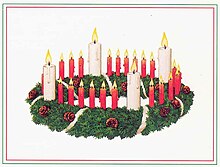Advent wreath
The Advent wreath, or Advent crown, is a Christian tradition that symbolizes the passage of the four weeks of Advent in the liturgical calendar of the Western church. It is traditionally a Lutheran practice, although it has spread to many other Christian denominations.[1][2][3]
It is usually a horizontal evergreen wreath with four candles, sometimes with a fifth, white candle in the center. Beginning with the First Sunday of Advent, the lighting of a candle can be accompanied by a Bible reading, devotional time and prayers.[4][5] An additional candle is lit during each subsequent week until, by the last Sunday before Christmas, all four candles are lit. Many Advent wreaths include a fifth, Christ candle which is lit at Christmas Eve or Christmas Day.[6] The custom is observed both in family settings and at public church services.
History
The concept of the Advent wreath originated among German Lutherans in the 16th Century.[7] However, it was not until three centuries later that the modern Advent wreath took shape.[8]

Research by Prof. Haemig of Luther Seminary, St. Paul, points to Johann Hinrich Wichern (1808–1881), a Protestant pastor in Germany and a pioneer in urban mission work among the poor as the inventor of the modern Advent wreath in the 19th century.[9] During Advent, children at the mission school Rauhes Haus, founded by Wichern in Hamburg, would ask daily if Christmas had arrived. In 1839, he built a large wooden ring (made out of an old cartwheel) with 20 small red and 4 large white candles. A small candle was lit successively every weekday and Saturday during Advent. On Sundays, a large white candle was lit. The custom gained ground among Protestant churches in Germany and evolved into the smaller wreath with four or five candles known today. Roman Catholics in Germany began to adopt the custom in the 1920s, and in the 1930s it spread to North America.[10] Professor Haemig's research also indicates that the custom did not reach the United States until the 1930s, even among German Lutheran immigrants.
In Medieval times Advent was a fast during which people's thoughts were directed to the expected second coming of Christ; but in modern times it has been seen as the lead up to Christmas, and in that context Advent Wreath serves as a reminder of the approach of the feast.
In 1964, an Advent crown made at home from wire coathangers and tinsel, appeared on the bi-weekly children's TV program Blue Peter. This 'make' became one of the program's most iconic, repeated each year, and was the introduction of this tradition to most of the broadly Anglican audience.[11] In later years, the candles were replaced by baubles, out of concern over fire.
More recently, some Eastern Orthodox families have adopted an Advent wreath with six candles symbolizing the longer Christmas fast in Orthodox tradition, which corresponds to Advent in Western Christianity.[12]
Forms of the Advent wreath
Advent wreaths are circular, representing God's infinite love, and are usually made of evergreen leaves, which "represent the hope of eternal life brought by Jesus Christ."[13] Within the Advent wreath are candles that generally represent the four weeks of the Advent season as well as "the light of God coming into the world through the birth of Jesus Christ" although each of the candles has its own significance as well;[13] individually, the candles specifically symbolize the Christian concepts of hope (week one), peace (week two), joy (week three) and love (week four) in many traditions.[14][15][16][17] Many Advent wreaths also have a white candle in the centre to symbolize the arrival of Christmastide, sometimes known as the "Christ candle." It is lit on Christmas Eve or Christmas Day. The Christ candle is coloured white because this is the traditional festal colour in the Western Church.[18]
In many Catholic and Protestant churches, the most popular colours for the four surrounding Advent candles are violet and rose, corresponding with the colors of the liturgical vestments for the Sundays of Advent. For denominations of the Western Christian Church, violet is the historic liturgical color for three of the four Sundays of Advent: Violet is the traditional color of penitential seasons.[16] Blue is also a popular alternative color for both Advent vestments and Advent candles, especially in some Anglican and Methodist churches,[16] which use a blue shade associated with the Sarum rite, in addition to Lutheran churches that also implement this practice. One interpretation holds that blue means hope and waiting, which aligns with the seasonal meaning of Advent. Rose is the liturgical color for the Third Sunday of Advent, known as Gaudete Sunday from the Latin word meaning "to rejoice"—also from the first line of the traditional entrance prayer (called the Introit) for the Mass or Worship Service of the third Sunday of Advent; it is a pause from the penitential spirit of Advent.[19][20] As such, the third candle, representing joy, is often a different color from the other three.[16][14]
In other Protestant churches, especially in the United Kingdom, it is more common for Advent wreaths to have four red candles (reflecting their traditional use in Christmas decorations).[21] The Advent wreath used by Pope Benedict XVI of the Catholic Church also had four red candles.[22]
See also
References
- ^ Peter C. Bower. The Companion to the Book of Common Worship. Office of Theology and Worship, Presbyterian Church (U.S.A.). Retrieved 2010-12-02.
It apparently emanated from the Lutheran tradition, but it has been appropriated by almost all other traditions.
- ^ John Trigilio, Kenneth Brighenti. The Catholicism Answer Book: The 300 Most Frequently Asked Questions. Sourcebooks. Retrieved 2010-12-02.
Historically, the Advent wreath is a Lutheran custom dating back three hundred years ago.
- ^ Carl Seaburg. Celebrating Christmas: An Anthology. Unitarian Universalist Ministers Association. Retrieved 2010-12-02.
The use of an Advent Wreath originated a few hundred years ago among Lutherans in Germany.
- ^ Geddes, Gordon; Griffiths, Jane (2001). Christianity. Heinemann. p. 96. ISBN 9780435306953.
Every day during Advent, the candle is lit and burnt down to the next number. In many homes, a reading from the Bible and a prayer accompanies the lighting of the candle.
- ^ Bradner, John (1977). Symbols of Church Seasons and Days. Morehouse-Barlow Company. ISBN 9780819212283.
The Advent wreath usually rests on a horizontal surface. This is especially appropriate when it is used in the home as the center for daily Advent devotions.
- ^ Dennis Bratcher. The Season of Advent: Anticipation and Hope. Christian Research Institute. Archived from the original on 2011-01-02. Retrieved 2010-12-02.
Finally, the light that has come into the world is plainly visible as the Christ candle is lighted at Christmas, and worshippers rejoice over the fact that the hope and promise of long ago have been realized.
{{cite book}}: Unknown parameter|deadurl=ignored (|url-status=suggested) (help) - ^ Colbert, Teddy (1996). The Living Wreath. Gibbs Smith. ISBN 9780879057008.
It is believed that the European advent wreath began as a Lutheran innovation in the sixteenth century.
- ^ Mosteller, Angie (2010-05-15). Christmas, Celebrating the Christian History of Classic Symbols, Songs and Stories. Holiday Classics Publishing. p. 167. ISBN 098456490X.
The first clear association with Advent is generally attributed to German Lutherans in the 16th century. However, another three centuries would pass before the modern Advent wreath took shape. Specifically, a German theologian and educator by the name of Johann Hinrich Wichern (1808-1881) is credited with the idea of lighting an increasing number of candles as Christmas approached.
- ^ BAYERN TOURISMUS Marketing GmbH (2013-12-29). "Bavaria- Christmas customs and recipes - Christmas customs - Tradition - About Bavaria". BAYERN TOURISMUS Marketing GmbH. Retrieved 2015-11-23.
- ^ "Johann Hinrich Wichern biography (in German)". Medienwerkstatt-online.de. 2008-01-05. Retrieved 2011-12-20.
- ^ An Advent Crown for Christmas. BBC.
{{cite book}}:|work=ignored (help) - ^ "Orthodoxy Today". Orthodoxy Today. 2010-02-02. Retrieved 2011-12-20.
- ^ a b Geddes, Gordon; Griffiths, Jane (2002). Christian Belief and Practice. Heinemann. p. 97. ISBN 9780435306915.
The wreath's circle reminds Christians of God's endless love and mercy. The evergreen leaves represent the hope of eternal life brought by Jesus Christ. The candles symbolize the light of God coming into the world through the birth of Jesus Christ.
- ^ a b "Advent Wreath Prayers" (PDF). St. Robert Bellarmine Parish: A Roman Catholic Faith Community. Retrieved 25 November 2016.
The first week of Advent we remember the gift of hope we have in Christ. ... The second week of Advent we remember the gift of Peace we have in Christ. ... The third week of Advent we remember the gift of Joy we have in Christ. ... The fourth week of Advent we remember the gift of Love we have in Christ.
- ^ Howe, Heath (2013). "The Gifts of Hope, Peace, Joy and Love". Episcopal Church of the Holy Comforter. Retrieved 25 November 2016.
Week one of Advent we light one candle on the Advent wreath and reflect on the gift of Hope. Week two we dedicate to Peace. Week three honors Joy. Week four, Love.
- ^ a b c d "What do the candles in our Advent wreath mean?". The United Methodist Church. Retrieved 25 November 2016.
The Advent wreath, four candles on a wreath of evergreen, is shaped in a perfect circle to symbolize the eternity of God. In some churches, four purple candles, one for each week in Advent, are used with one larger white candle in the middle as the Christ candle. Other churches prefer three purple or blue candles with one candle being rose or pink, to represent joy. ...During each Sunday of the Advent season, we focus on one of the four virtues Jesus brings us: Hope, Love, Joy and Peace.
- ^ "Presbyterian Church (U.S.A.) - Resources - Lighting the Advent Wreath in the Tradition of Hope, Peace, Joy, and Love". 2016-07-30. Archived from the original on 2016-07-30. Retrieved 2018-03-22.
{{cite web}}: Cite has empty unknown parameter:|dead-url=(help) - ^ Garrison, Greg (27 November 2010). "Birmingham Catholic Bishop Robert J. Baker writes Advent devotional". The Birmingham News. Retrieved 31 January 2016.
An Advent wreath is traditionally made of evergreens in a circle, symbolizing God's unending love. It includes three purple candles, and the candle for the third week of Advent is pink in most Advent wreaths. It signifies the hope of the coming of Christ, Baker said. "Hope is needed in our culture," Baker said. "People are struggling economically. People are in dire need of hope." For Christians, that hope comes from the birth of Jesus, he said. For the first week, there is one purple candle lit on the Advent wreath every day. Another is added the second week. A pink candle is lit the third week, another purple candle the fourth week. The three purple candles and the pink candle are all lit on the last Sunday before Christmas and throughout that week. A white candle at the center of most Advent wreaths, the Christ candle, is lit on Christmas day, Baker said.
- ^ "Catholic Encyclopedia: Advent". Newadvent.org. 1907-03-01. Retrieved 2011-12-20.
- ^ "What Color is Lent?". Adoremus.org. Retrieved 2011-12-20.
- ^ BBC News, "Christian celebration of Advent" (BBC Mobile, 16 November 2010, accessed December 19, 2010).[1]
- ^ Manning, Kathleen (2015). "Why are Advent candles pink and purple?". U.S. Catholic Magazine. Retrieved 25 November 2016.
In 2006 photographers snapped a few shots of the Advent wreath in Benedict XVI's office. The German pontiff's wreath featured four red candles.
External links
- Advent wreath FAQ at the Evangelical Lutheran Church in America web site
- Advent hymns including two examples of Advent Wreath carols
- Advent Bible Themes






